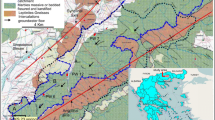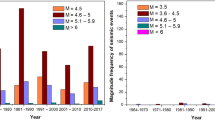Abstract
Eight spatial structure types are determined through morphology, hydrogeology, hydrology and impulse response in karst districts, with the well studied Houzhai subterranean stream in Puding, Guizhou Province as a sample research area. These types contain peak-forest basin, peak-forest laterite platform, resurrected peak-forest basin, old peak-forest-funnel depression, peak-forest-funnel, peak-forest-funnel depression, peak-cluster valley and peak-forest-doline. In the area, each of them has its respective surface and subterranean structural feature, and morphology, hydrogeology, hydrology and impulse response as well. The difference of responses of subsurface system in different spatial structure types are obtained by time series analysis, frequency spectrum research and decline curve calculation of material current. According to the analysis of the aquifer feature, the upper reaches of suburfall stream is dominated by pipeline flow, the lower reaches is characterized by braided fissure flow drainage system and mixed characteristic exists in the middle reaches. The result of the impulse test shows that the large ascending range of stage in the test on swash condition is in fissure system. However, in pipeline type, especially in the subterranean stream where there is waterfall or incomplete fill of underground water, the ascending range of stage is one quantity level less than the impulse range of stage at some fissure types, showing that change range of stage can indicate the spatial structure characteristics of certain area upper the station. The main direction of karst geomorphic evolution there is positive course except in the west area. It can be seen that karst geomorphological evolution direction can change when discharge datum plane influences some part of a relatively large drainage. In certain time unit, the upper reaches are controlled by old datum plane and the lower reaches by new datum plane. Two opposite geomorphological evolution directions can exist in one drainage.
Similar content being viewed by others
References
Foed D.C., Williams P.W. 1989. Karst Geomorphology and Hydrology. London: Oxford University Press.
Tan Ming, 1991. Mathematical modelling of hydrogeomorphology and its application in the karst of Guizhou, China. Acta Geographica Sinca, 46(4): 460–469. (in Chinese)
Voss R. F, 1988. Frractals in nature from characterization to simulation. The Science of Fractal Images. New York: Springer-verlag.
Yu Jinbiao et al., 1990. Typical Study on Developmental Regularity of Karst in China. Beijing: Science Press. 41–169. (in Chinese)
Zhu Xuewen, 1991. New considerations on characteristics and evolution of fenglin karst. Carsologica Sinica, 10(1,2,3): 51, 137, 171. (in Chinese)
Zhang Zhaogan et al., 1996. Classification and characters of karst surface spatial structure in Puding, Guizhou. Journal of Nanjing University (Natural Sciences), 32 (2): 302–308. (in Chinese)
Author information
Authors and Affiliations
Rights and permissions
About this article
Cite this article
Zhang, Z., Zhang, J., Yang, J. et al. Research on the spatial structure of karst massif. Chin. Geograph.Sc. 8, 256–263 (1998). https://doi.org/10.1007/s11769-997-0019-8
Received:
Issue Date:
DOI: https://doi.org/10.1007/s11769-997-0019-8




